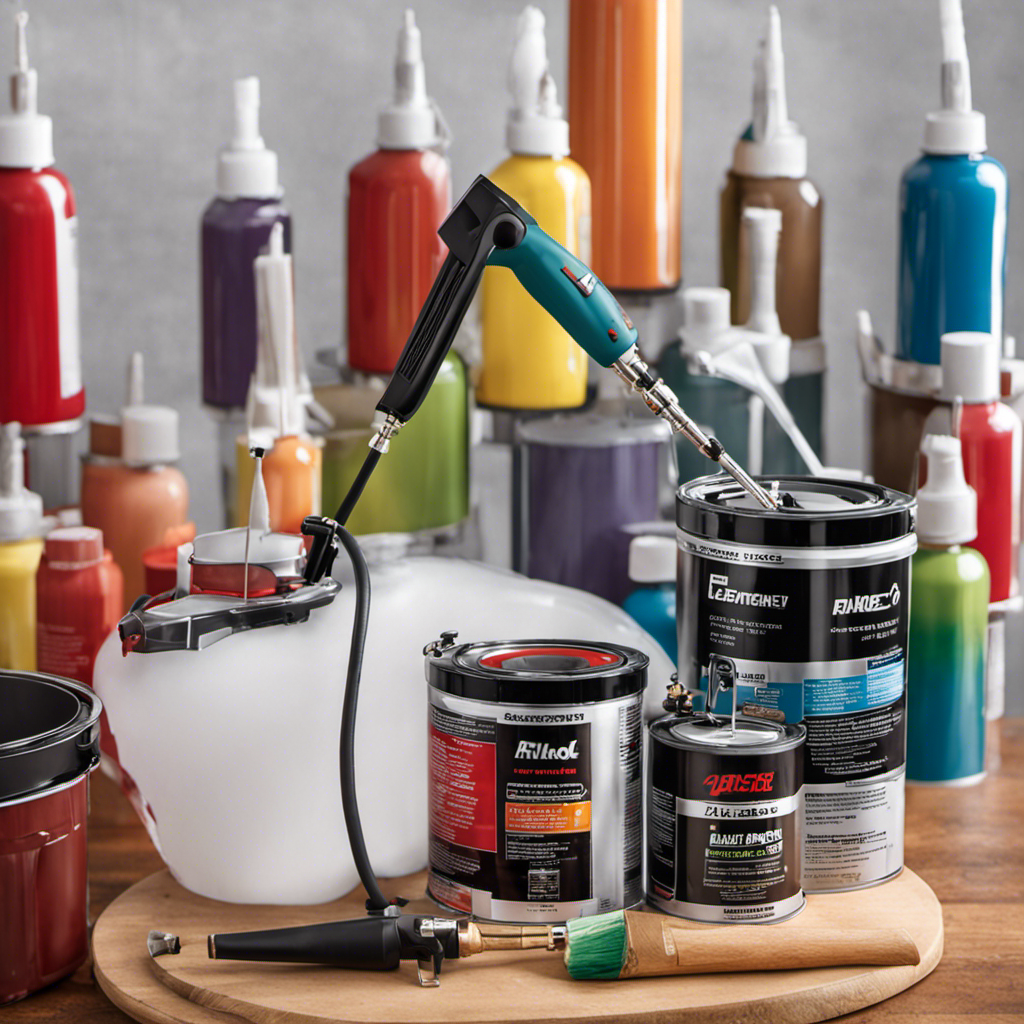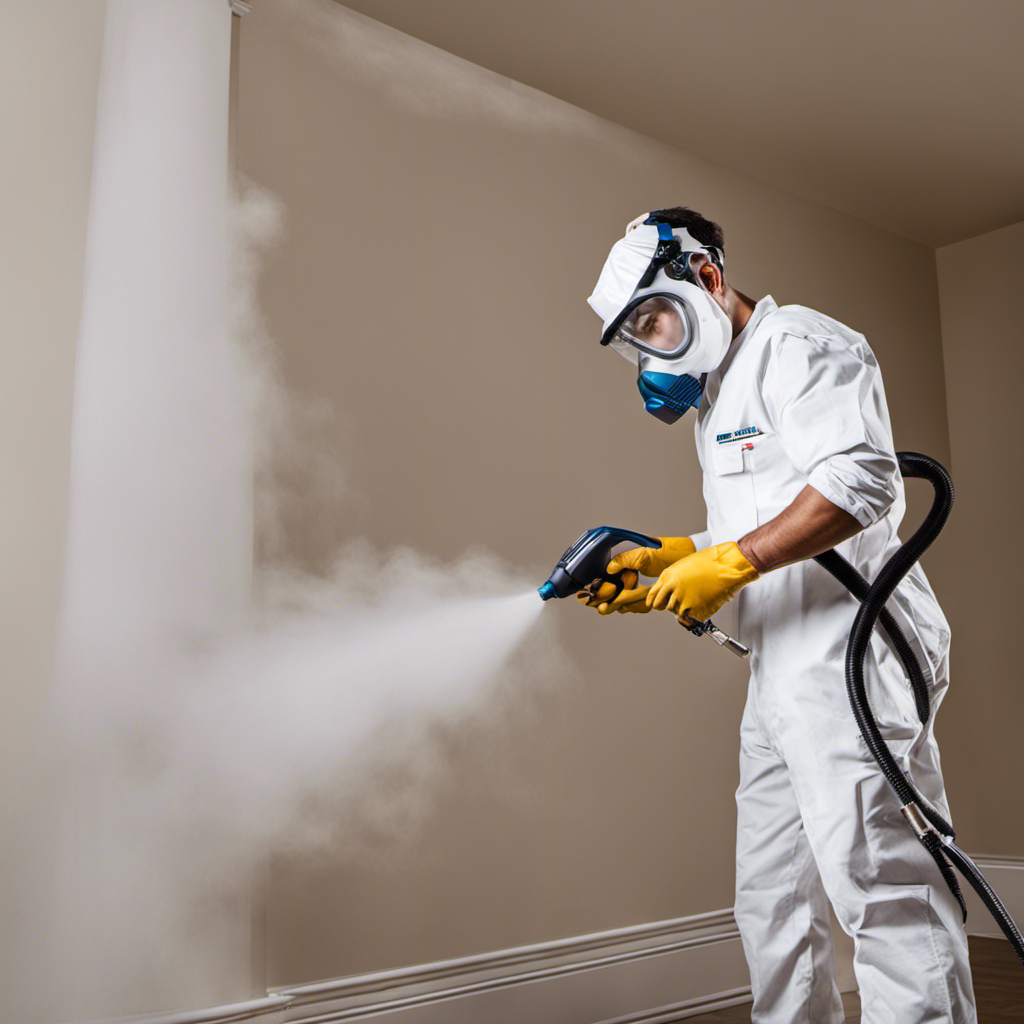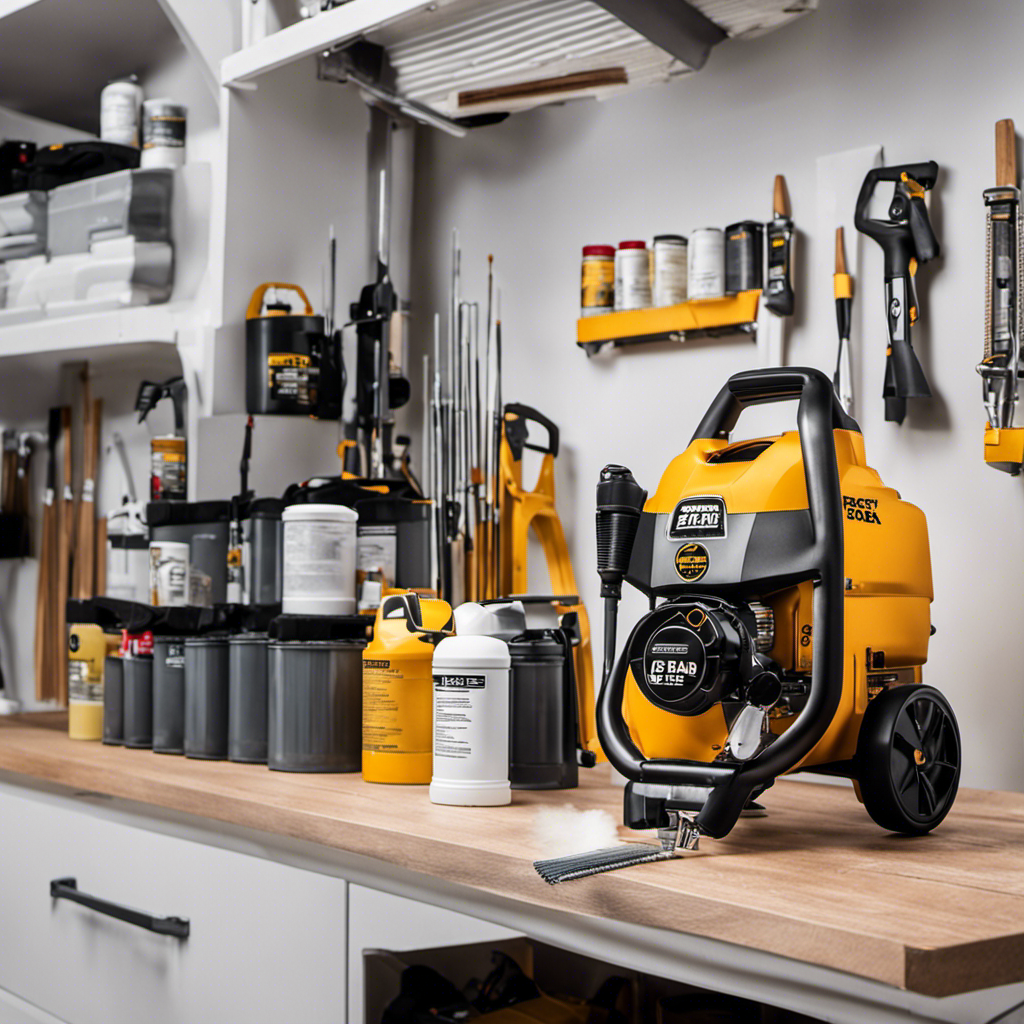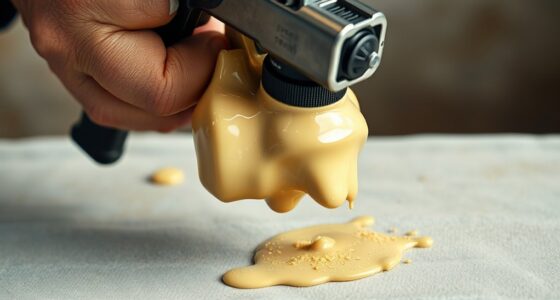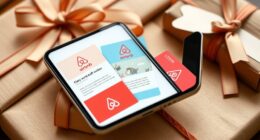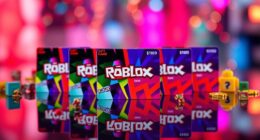When it comes to choosing an airless paint sprayer gun, there are many options available. Whether you’re using latex, oil-based, acrylic, enamel, or anything in between, there is a suitable paint type for every project.
Latex paints offer easy cleanup and a professional finish, while oil-based paints provide superior adhesion and durability. Acrylic paints offer vibrant colors and quick drying time, while enamel paints give a glossy finish.
With so many choices, the possibilities are endless. So, let’s dive in and explore the world of compatible paints for airless paint sprayers.
Key Takeaways
- Latex paints offer easy cleanup, low odor, quick drying time, and a smooth and professional finish.
- Oil-based paints provide superior adhesion, excellent durability, and great coverage for high-traffic areas.
- Acrylic paints offer vibrant colors, quick drying time, and excellent adhesion, making them suitable for professional artists and beginners.
- Enamel paints provide a glossy finish, durability, and resistance to chipping and fading, making them recommended for high-traffic areas.
Latex Paints
Latex paints, which are water-based and offer easy cleanup, quick drying, low odor, and a smooth and professional finish, are considered ideal for indoor use.
One of the advantages of using latex paints for interior walls is their ease of application. They can be applied with a brush, roller, or airless paint sprayer, making them versatile and convenient.
When using an airless paint sprayer, it is important to properly clean and maintain the equipment for optimal performance. After each use, the sprayer should be thoroughly cleaned by flushing it with water or a cleaning solution recommended by the manufacturer. This helps prevent clogs and ensures that the sprayer is ready for the next use.
Regular maintenance, such as checking for worn or damaged parts, will also prolong the lifespan of the sprayer and ensure consistent results.
Oil-based Paints
Oil-based paints offer superior adhesion, durability, and excellent coverage on various surfaces such as wood, metal, and concrete. These paints have several advantages over other types, making them a popular choice for many projects. One advantage is their ability to adhere well to surfaces, ensuring a long-lasting finish. Additionally, oil-based paints are highly durable, making them suitable for high-traffic areas or surfaces that are prone to wear and tear. Another advantage is their excellent coverage, allowing for fewer coats and saving time and effort.
When applying oil-based paints, there are a few tips to keep in mind for optimal results. Firstly, it is important to properly prepare the surface by cleaning and sanding it to ensure proper adhesion. Additionally, using a high-quality brush or roller can help achieve a smooth and even finish. It is also crucial to allow sufficient drying time between coats to prevent smudging or unevenness. Lastly, proper ventilation is essential when working with oil-based paints due to their strong odor and potential fumes. By following these tips, one can effectively apply oil-based paints and enjoy their many advantages.
| Advantages of Using Oil-based Paints | Tips for Applying Oil-based Paints Effectively |
|---|---|
| Superior adhesion | Properly prepare the surface before painting |
| Durability | Use high-quality brushes or rollers |
| Excellent coverage | Allow sufficient drying time between coats |
| Suitable for various surfaces | Ensure proper ventilation during painting |
Acrylic Paints
Acrylic paints offer vibrant colors and a wide range of possibilities, making them a popular choice for many artists and DIY enthusiasts. These paints are known for their quick drying time and excellent adhesion to various surfaces.
One of the advantages of using acrylic paints is their ability to create different textures, from thin washes to thick impasto. Artists can experiment with various acrylic paint techniques, such as glazing, stippling, and dry brushing, to achieve unique effects in their artwork.
When it comes to choosing the best acrylic paint brands, some popular options include Liquitex, Golden, and Winsor & Newton. These brands are known for their high-quality pigments and consistency, allowing artists to achieve vibrant and long-lasting results in their paintings.
Whether you are a professional artist or a beginner, acrylic paints provide endless possibilities for creativity and expression.
Enamel Paints
Enamel paints, known for their glossy finish and durability, are recommended for high-traffic areas and require proper surface preparation and cleaning for optimal performance.
Advantages of using enamel paints:
- Provides a glossy finish that adds a touch of elegance to any surface.
- Offers exceptional durability, making it resistant to chipping, fading, and staining.
- Ideal for high-traffic areas due to its ability to withstand wear and tear.
Tips for achieving a smooth finish with enamel paints:
- Ensure the surface is clean and free from dust, grease, and debris before applying the paint.
- Use a high-quality brush or roller to ensure even coverage and minimize streaks.
- Apply thin coats of paint and allow sufficient drying time between each coat for best results.
Chalk Paints
Chalk paints, known for their matte finish and versatile application, have gained popularity in the world of furniture restoration and DIY projects. These paints are perfect for refinishing furniture and achieving a distressed look.
When using chalk paints for furniture refinishing, there are a few tips to keep in mind. First, make sure to clean and prep the surface before applying the paint. This will help the paint adhere better and ensure a smooth finish.
Next, consider using a brush or a foam roller for application, as they can help achieve a more textured look. To create a distressed look, gently sand the edges and corners of the painted piece after it has dried. This will give it a worn and aged appearance.
Finally, seal the painted furniture with a clear wax or topcoat to protect the finish and enhance its durability.
With these tips, anyone can achieve a beautiful distressed look using chalk paints for furniture refinishing.
Spray Paints
After exploring the versatility of chalk paints, let’s dive into another popular option for painting projects: spray paints. Spray paints offer a convenient and efficient way to achieve smooth and even coverage on various surfaces. They come in a wide range of colors and finishes, making them suitable for both indoor and outdoor applications.
Advantages of using spray paints include:
- Quick application: Spray paints allow for faster and more precise coverage compared to traditional brush painting.
- Smooth finish: The fine mist of spray paints creates a smooth, professional-looking finish.
- Versatility: Spray paints can be used on a variety of materials, including wood, metal, plastic, and more.
However, there are some limitations to consider:
- Overspray: Without proper technique, spray paints can result in overspray, leading to wasted paint and mess.
- Limited control: Achieving intricate details or patterns may be challenging with spray paints.
- Ventilation requirements: Spray painting should always be done in a well-ventilated area to avoid inhaling fumes.
To use spray paints effectively, keep these essential tips in mind:
- Shake the can thoroughly before use to ensure proper mixing of the paint.
- Maintain a consistent distance (usually 8-12 inches) between the can and the surface for even coverage.
- Apply multiple thin coats rather than a single heavy coat to prevent drips and achieve a smoother finish.
With these tips and an understanding of the advantages and limitations, you can make the most of spray paints for your next painting project.
Stain and Varnish
Stain and varnish are popular options for adding color and protection to wood surfaces. When it comes to stain removal techniques, there are a few effective methods to consider.
For water-based stains, a mixture of dish soap and warm water can often do the trick. Simply apply the solution to the stained area, scrub gently, and rinse with clean water.
For oil-based stains, mineral spirits or acetone can be used to remove the stain. It’s important to test these solutions on a small, inconspicuous area first to ensure they don’t damage the wood.
As for the best varnish for wood furniture, it ultimately depends on the desired finish and level of protection. Polyurethane varnish is a popular choice as it provides a durable and glossy finish. Water-based varnishes are also a good option for those looking for a low odor and easy cleanup.
Primer Paints
Primer paints are essential for creating a smooth and even surface on various materials before applying the final coat of paint. When it comes to primer paint application techniques, it is important to choose the right primer for different surfaces. Here are some tips to consider:
-
Surface preparation: Before applying primer, make sure the surface is clean, dry, and free from any loose particles or grease. This will help the primer adhere better and provide a strong foundation for the paint.
-
Choosing the right primer: Different surfaces require different types of primers. For example, a latex primer is suitable for drywall and wood, while an oil-based primer works best on metal and previously painted surfaces. Acrylic primers are versatile and can be used on multiple surfaces.
-
Application method: Whether using a brush, roller, or spray gun, apply the primer evenly and in thin coats. This will ensure proper coverage and prevent drips or uneven drying.
Specialty Paints (E.G., Metallic, Glitter
When it comes to specialty paints, metallic and glitter paints are popular choices for adding a touch of glamour and shine to any project.
Metallic paint offers a unique finish that mimics the look of metal, providing a luxurious and eye-catching effect. It can be used on various surfaces, including furniture, walls, and decorative items.
The benefits of using metallic paint include its ability to create a striking visual impact, its durability, and its versatility in terms of color options.
On the other hand, glitter paint adds sparkle and shimmer to surfaces, making them stand out in any room.
When applying glitter paint, it is important to prepare the surface properly by cleaning and priming it. It is recommended to apply multiple thin coats of glitter paint to achieve the desired effect, allowing each coat to dry completely before applying the next. This ensures an even distribution of glitter particles and prevents clumping.
Additionally, using a brush or roller specifically designed for glitter paint can help achieve a smooth and consistent application.
Benefits and Features of Latex Paints
The benefits of using latex paints include their water-based formula, easy cleanup, quick drying time, low odor, and smooth and professional finish.
Latex paints have several advantages over oil-based paints. Firstly, latex paints are more environmentally friendly as they are water-based and contain fewer harmful chemicals.
Secondly, latex paints are easier to clean up as they can be washed off with water and soap.
Lastly, latex paints have a quick drying time, allowing for faster completion of painting projects.
In contrast, oil-based paints have superior adhesion and durability, making them suitable for various surfaces such as wood, metal, and concrete. However, they can be more difficult to clean up and have a stronger odor.
Overall, latex paints are a popular choice for indoor painting projects due to their ease of use and high-quality finish.
Benefits and Features of Oil-based Paints
Oil-based paints are a popular choice for airless paint sprayers due to their superior adhesion and durability. These paints form a strong bond with surfaces, ensuring that the paint stays put for a long time. They are known for their excellent coverage, making them suitable for various surfaces such as wood, metal, and concrete.
Oil-based paints also offer a level of durability that is hard to match. They can withstand the elements and are recommended for high-traffic areas. Additionally, these paints provide a smooth and professional finish, giving your project a polished look.
However, it is important to note that oil-based paints require proper surface preparation and cleaning for optimal performance. With their exceptional adhesion and long-lasting results, oil-based paints are a reliable choice for any painting project.
Frequently Asked Questions
Can I Use Any Type of Paint With an Airless Paint Sprayer Gun?
Yes, you can use different types of paint with an airless paint sprayer gun. However, it’s important to take safety precautions and ensure compatibility with the specific paint type.
Latex, oil-based, acrylic, and enamel paints are commonly used with airless sprayers. Each type has its own benefits and features, such as quick drying time, excellent coverage, and a smooth finish.
It’s recommended to follow the manufacturer’s guidelines and properly prepare the surface for optimal performance.
Are There Any Safety Precautions I Should Take When Using an Airless Paint Sprayer With Oil-Based Paints?
When using an airless paint sprayer with oil-based paints, it’s important to take proper safety precautions. This includes wearing protective gear such as gloves, goggles, and a respirator to avoid contact with the paint and inhalation of fumes.
Additionally, ensure proper ventilation in the area where you are working to minimize exposure to harmful chemicals.
Proper handling and cleaning of the sprayer after use is also crucial to prevent any paint residue from causing issues in future applications.
Can I Use Enamel Paints With an Airless Paint Sprayer for Both Indoor and Outdoor Projects?
Enamel paints can be used with an airless paint sprayer for both indoor and outdoor projects. However, there are some pros and cons to consider.
Enamel paints provide a glossy and durable finish, making them ideal for high-traffic areas. They require proper surface preparation and cleaning for optimal performance.
To achieve a smooth finish, it is recommended to apply multiple thin coats rather than one thick coat. Additionally, using a high-quality airless paint sprayer and following the manufacturer’s instructions is essential.
Are There Any Special Considerations When Using Chalk Paints With an Airless Paint Sprayer?
When using chalk paints with an airless paint sprayer, there are a few tips and tricks to achieve a smooth finish.
Firstly, it’s important to thin down the chalk paint to a consistency that can be easily sprayed.
Secondly, make sure to clean the sprayer thoroughly before and after use to prevent clogging.
Additionally, applying multiple thin coats rather than one thick coat can help achieve a more even and professional-looking finish.
Can I Use Metallic or Glitter Specialty Paints With an Airless Paint Sprayer, or Do I Need a Different Type of Sprayer for Those?
Yes, an airless paint sprayer can be used for metallic or glitter specialty paints. However, for optimal results with textured finishes, it is recommended to use specialty paint sprayers specifically designed for those types of paints.
These sprayers are equipped with features that allow for better control and application of textured paints, ensuring a more even and professional finish.
It is important to follow the manufacturer’s instructions and guidelines when using any type of paint with an airless paint sprayer.
Conclusion
In conclusion, there is a wide range of compatible paints for airless paint sprayer guns. This includes latex, oil-based, acrylic, enamel, and more! Each type of paint offers unique benefits and features that cater to different needs and preferences.
Latex paints provide easy cleanup and a professional finish. They are great for indoor use and are water-based, making them environmentally friendly.
Oil-based paints offer superior adhesion and durability. They are perfect for surfaces that require extra protection, such as metal or wood. However, they do require mineral spirits for cleanup.
Acrylic paints provide vibrant colors and quick drying time. They are versatile and can be used on a variety of surfaces, including wood, metal, and plastic. They are also easy to clean up with water.
Enamel paints provide a glossy finish and durability. They are commonly used for high-traffic areas, such as doors and trim. They are also resistant to stains, making them suitable for kitchens and bathrooms.
With the right paint choice, anyone can achieve a smooth and flawless paint job with an airless paint sprayer gun. So, consider your needs and preferences, and choose the paint that best suits your project.
Franz came aboard the Paint Sprayer Zone team with a background in both journalism and home renovation. His articulate writing style, combined with a passion for DIY projects, makes him an invaluable asset. Franz has a knack for breaking down technical jargon into easy-to-understand content, ensuring that even the most novice of readers can grasp the complexities of paint sprayers.
